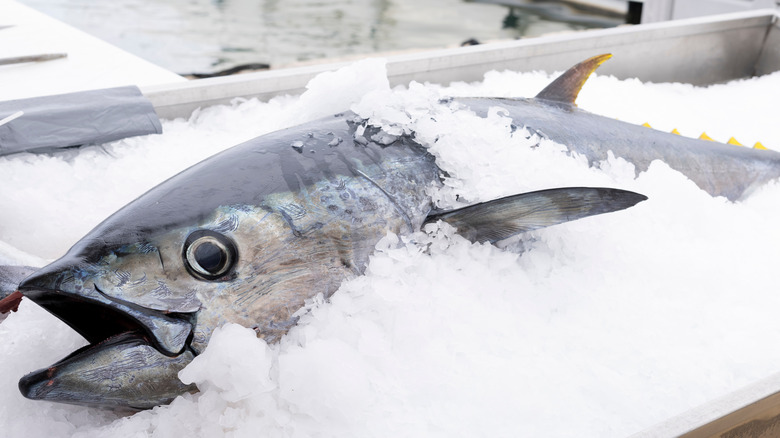Why Frozen Tuna Is Considered Just As High-Quality As Fresh Tuna
No one will argue that a frozen cardboard boxed lasagna is better than a freshly baked layered labor of love. Similarly, few would seem prone to favor a supermarket pizza from the frozen foods aisle over a steaming-hot fresh pie delivery arriving at your door. In fact, there are a number of foods you should simply never try to freeze. However, when it comes to fish, the difference between fresh and frozen isn't quite so cut and dry.
The freezing of freshly-caught tuna has its roots in the '60s. At that time, the professional equipment available on fishing boats was only able to achieve a temperature of negative 25 degrees Celsius. It wasn't until the 2000s that a substantial deep freeze of negative 100 degrees was attainable with newer technology. As the popularity of sushi across the globe continues to grow, an even higher quality of frozen fish will be reached (via Asahi).
So is fresh always best? Not necessarily, when it comes to tuna — frozen fish are just as good as fresh fish when done properly. So, why is frozen tuna considered just as high-quality as fresh tuna?
What is the difference between frozen and fresh tuna?
Fresh tuna is pretty straightforward — any fish in the case sporting the word "fresh" means it has never been frozen. While the meat has never officially dropped below the freezing point, it may be up to two weeks old due to transportation and processing times by the time it reaches your store shelves as a "fresh" option, per The Better Fish. Fresh tuna is caught by local fishermen and put on ice for a period of time before it heads back to shore and is refrigerated on store shelves (via Michelin Guide).
Just as fruits and vegetables are flash-frozen at their peak of ripeness, frozen tuna is immediately frozen onboard the fishing boat with industrial flash freezers. The goal is to chill the flesh before blood loss occurs and rigor mortis sets in. Industrial flash freezing freezes the inside and outside of the water cells in the meat simultaneously, as compared to regular freezing which moves from the outside to the inside of the cell. The industrial process of flash freezing preserves the integrity of the meat from a texture, taste, and nutritional standpoint.
If the fish is frozen too slowly without professional equipment, water will be released during thawing (along with some flavor) and affect the texture of the meat, per Asahi. Frozen tuna is typically caught during deep sea, long-distance fishing excursions. The meat usually spends about a year on the boat in industrial freezers, but freshness is not sacrificed due to the extremely deep freeze.
Frozen tuna best practices
Because of the extensive and immediate freezing process commercially fished tuna undergoes, not only is it just as good as fresh, some may even say it's of higher quality. Per MasterClass, when immediately frozen post-catch, tuna has less potential of having parasites than fresh. However, there are some rules of thumb to keep in mind when purchasing, defrosting, and preparing frozen tuna, to ensure you retain that quality.
The Food and Drug Administration suggests checking that the packaging is closed and free of any tears. The regulatory agency also cautions against eating any frozen tuna with visible ice crystals which may indicate it's been thawed and refrozen. It's also advised that frozen tuna customers make sure to check the firmness of the flesh to ensure that it's frozen solid. So long as it is not pliable, you should be good.
Once purchased, frozen tuna should be immediately transferred to your home freezer, or if you plan to consume it within two days, placed in a refrigerator set at 40 degrees Fahrenheit to defrost. Leave at least a day for it to properly thaw in the fridge. If you wish to cook it sooner, it can be immersed in cold water wrapped in plastic, or popped in the microwave on a defrost setting, and then cooked immediately.


